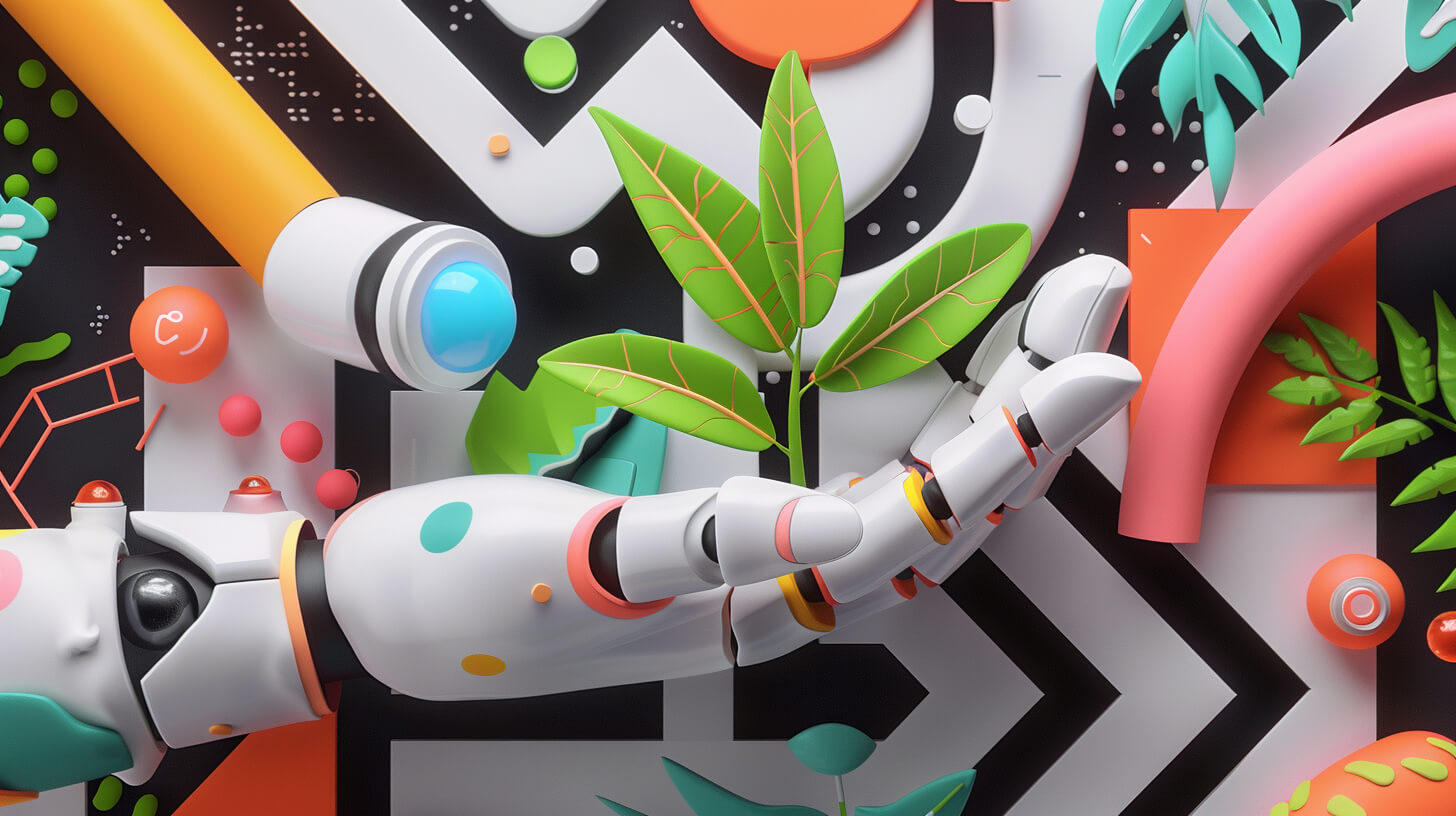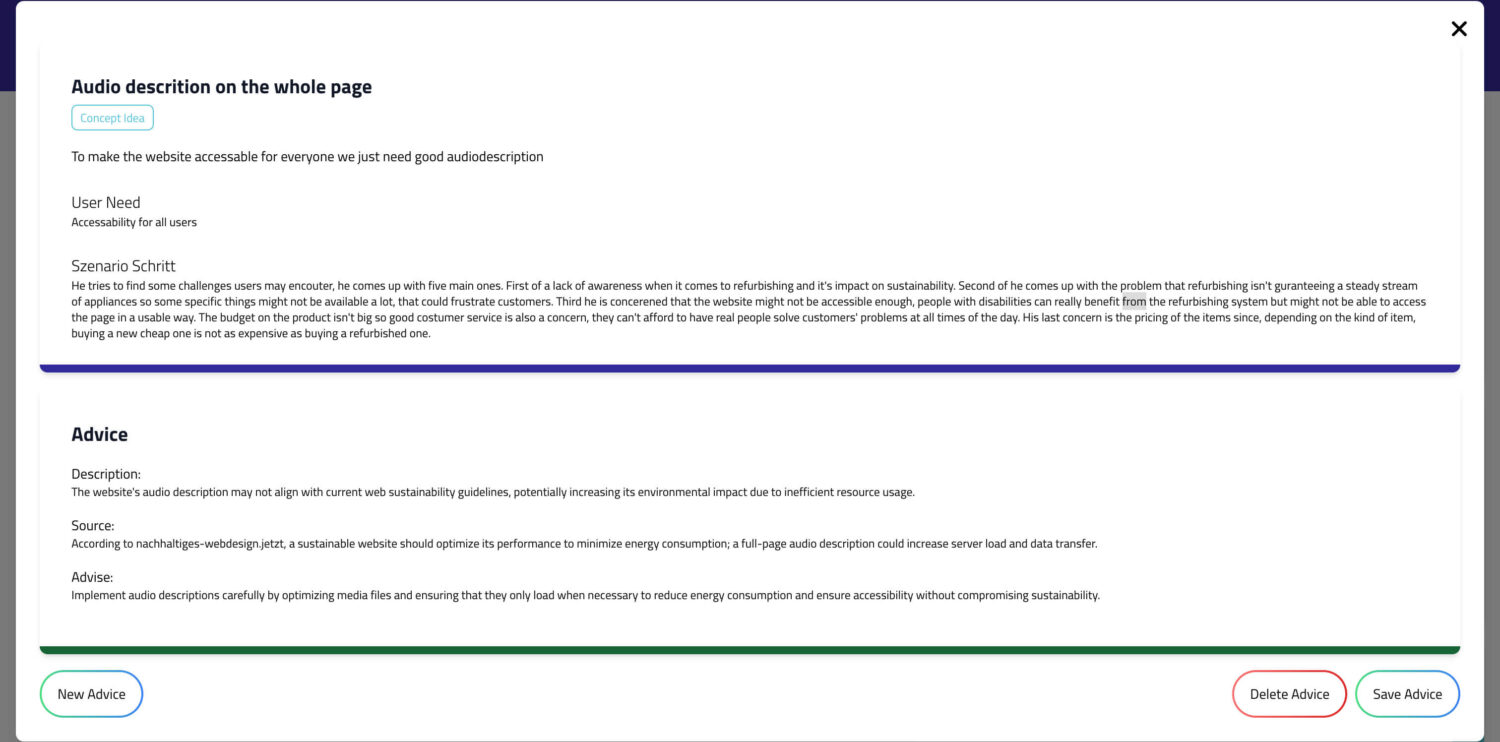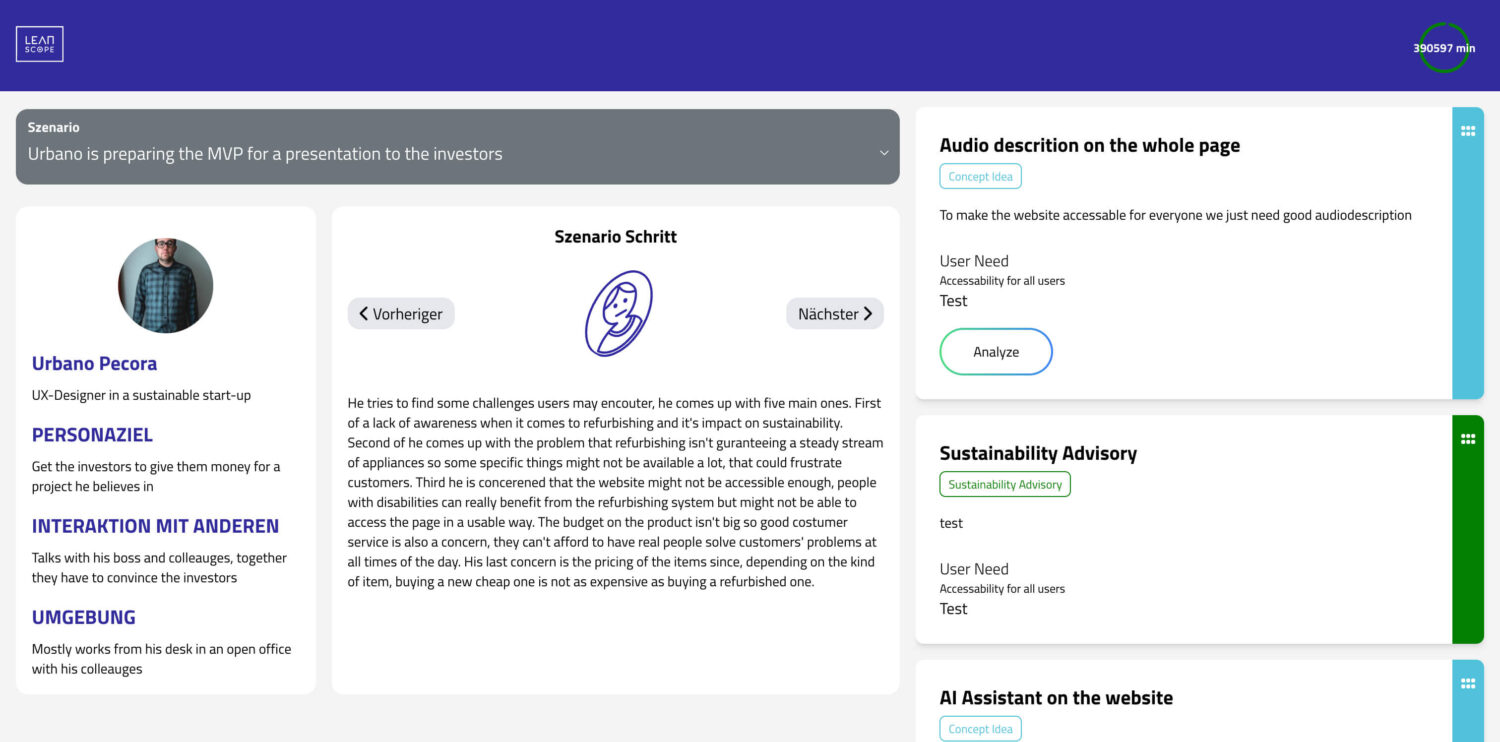
In today’s world, sustainability is more present than ever, while at the same time we are using more and more technology in our everyday lives. In the best case scenario, we combine these things. Unfortunately, most UX designers lack the theoretical knowledge to do this, which is where our media project comes in. We have developed an assistant realised with artificial intelligence. As a web application, this helps users to consider sustainability directly in LeanScope AI and to comply with the associated laws and guidelines. With Leanscope AI, CX and UX professionals can easily generate proto-personas, enrich them with UX research data and then even chat and brainstorm ideas with these personas. This makes it possible to gain a deeper understanding of the target group. The tool was developed in close cooperation with Centigrade.
The idea: initial steps and division of labour for our project
The media project is a course that we have to take as part of our Media Informatics degree programme in the higher semesters. We had several projects to choose from, but in the end we decided in favour of the “AI-powered sustainable UX” project by Centigrade. So we came together as a group of three: Alica, Kevin and Simone. Kevin has been working with websites and React for several years and quickly found his role as a programmer. Alica and Simone had already gained some experience with UI design and user research during their studies and were able to divide up these roles well.
The basic idea was to develop an assistant for LeanScope AI that helps designers when it comes to sustainability issues, the so-called “Eco Advisor”. For example, ideas that are not sustainable are to be “unmasked” as such so that digital products can be designed more sustainably from the ground up.
As mentioned, LeanScope AI helps to generate suitable ideas based on personas and their usage scenarios and to develop products from them. Our project is primarily focussed on having existing ideas evaluated from a sustainability perspective.
The focus here was on a proof of concept rather than a completely finished product. Shortly before the start of the project, OpenAI published the ChatGPT Playground, which made the implementation process much easier for us. Instead of programming directly in LeanScope, we then decided in favour of a web application that exchanges data directly with LeanScope and can be opened from there. We designed and programmed the application and conceptualised the wizard. We were able to test and verify the whole thing with user surveys. As previously mentioned, we divided the project into three areas: User research, UX design and programming. This allowed us to work in parallel and complement each other well.
UX design: developing the user interface and the AI persona
In the first step of the UX design, we worked on the persona of the AI. To do this, we first wrote scenarios in order to become aware of the exact application of the AI and to define the target group. The most interesting aspect here was the direction we decided to take with the motivation for sustainability. Parents, for example, are motivated by the desire to leave a better world for their children, which is obviously not the case for singles.
After some user research (more on this later), we settled on a key scenario involving a childless, relatively young UX designer working in a startup for sustainable electrical appliance refurbishing. We chose this persona because we came to the conclusion that such companies have the greatest interest in sustainability on the one hand, and on the other hand could take great risks if they are not aware of current laws and guidelines. They therefore derive the greatest benefit from our application and represent the main target group.
Our AI persona should now support our key persona, but how? The tone makes the music. We quickly realised that it was important for the AI to communicate with the user in a friendly manner and at eye level rather than from above. It was also important to us that it should appear trustworthy and have realistic expectations. By defining these characteristics, we were able to ensure that our assistant has a clear and consistent personality that meets the needs and expectations of our users.
The second part was about developing a prototype for our app. First we brainstormed individually, then we developed a low-fi prototype. Once this was finalised and we were able to verify it through user research, we moved on to high-fi prototype development. We used Figma for this. It started with the colour palette, we deliberately decided against the classic “climate green” and instead chose a blue similar to LeanScope. This is not only more consistent for LeanScope users, but also looks more serious and trustworthy. Based on this, we adopted the basic structure of the low-fi prototype and realised that some things look better in a rough sketch than in the actual design. After a few attempts, we had a solid, simple but professional-looking design, which we then passed on to the programming department.

Programming: Technical implementation of the AI
In this section, we focus on the implementation of the AI and not on the implementation of the user interface. We are primarily concerned with the following questions:
How can we give our assistants a personality?
Once we had developed a persona for the AI in the design, we had to think about how we could implement this technically. This was relatively easy to solve: In LeanScope itself, personas can be exported as a JSON file, and in the Playground you can give them too. If you save the JSON in the Playground, it is used for every request.
How do we ensure that Chat-GPT does not use false or dubious sources for the analysis?
Here we had to rely on previous research. We manually checked the sources and then approved them for the assistant.
How can we tell the assistant to always use the same approach to solve a problem in order to remain consistent?
We had to try it out and try it out some more. After some time, we found that it was most efficient to give the assistant precise steps to follow. This also applies in particular to the structure of the answers, as consistency is important here. The answers were described in small steps and limited in length. Rules were also specified, e.g. that the AI should not change the topic.
In conclusion, it can be said that programming an AI assistant is an ongoing process of experimentation and customisation. However, we were surprised at how quickly the assistant was able to provide good answers to sometimes complex legal questions.

UX research: Design of a user-centred AI assistant
We conducted user interviews in some places in order to develop as closely as possible to the users. All of our interviews were semi-structured, which led to some interesting (and sometimes lengthy) conversations and insights that we didn’t expect.
The first thing we did was verify our personas, in particular their frustrations and needs. To do this, we interviewed as many stakeholders as possible, including UX designers, lawyers and members of a sustainability organisation. The reasons given for acting sustainably were surprisingly diverse and ranged from “status and lifestyle” to “need for meaningfulness in one’s own actions” and “responsibility towards one’s own children”. The respondents’ frustrations also covered a broad spectrum. However, “greenwashing” and “too little demand for sustainable alternatives” were mentioned more frequently. Overall, the results told us a lot about the future focus of our project and largely confirmed or complemented our personas.
The second interviews focussed on the development and adaptation of the AI persona, and here the users were very unanimous: the ideas should be short, simple and feasible. They should not be formulated in a reproachful way and the assistant should appear natural, but not too human. It was also particularly important to the users that the AI did not provide incorrect information if there was no useful feedback on a particular point.
We then conducted interviews on the high-fi prototype. Here we focussed exclusively on the design and usability of the application and not on the output of the AI. The prototype was rated positively across the board, apart from a few minor details that were rated differently by different users: Should the chat function be predefined or open? Where is the persona displayed? These things then had to be decided and implemented by us.
After this process, there was only one thing left to do: the final test. Our focus during implementation was primarily on functionality. Due to the time pressure, the visual aspect had to suffer at one point or another. The feedback included, for example, the observation that the assistant responded to every query in English, which was perceived as disruptive in the German working environment. Furthermore, our final application was very confusing, as it turned out to be complicated to implement the design from LeanScope and the prototype. We also wanted the AI’s answers to be shorter and given in bullet points. However, it would then be necessary to be able to request more detailed information about individual key points by selecting them. All in all, however, the realisation of the idea was found to be good and users showed great interest in using the assistant in the future. The proof of concept was therefore definitely achieved.
To summarise, we were relatively surprised at how different feedback from the same user group can be. For example, workflows and needs seemed to vary greatly from person to person – what some saw as an advantage, others found annoying.

A look into the future: potential and further development and front-end expansion
To summarise, it can be said that it has been shown that it is possible to programme an AI assistant with a focus on sustainability and that there is also an interested target group. In addition to what has been achieved so far, the user interface still needs to be adapted to the high-fidelity prototype and some minor changes made to the prompt.
However, the potential of the end product is huge, UX design has an enormous impact on users and offers the opportunity to make a big difference. In addition, sustainability is interesting for companies as it saves money, time and labour. We therefore see great potential for actual utilisation and hope to be able to make a positive contribution to the digital future.
We have aroused your interest? Take a look at our services!


